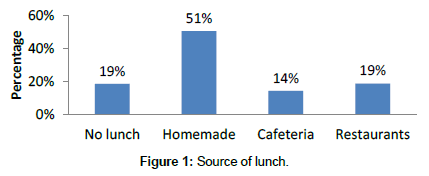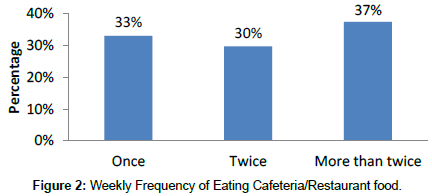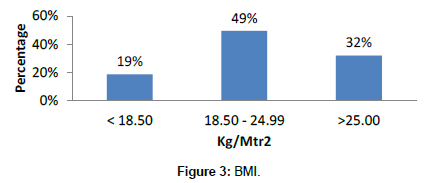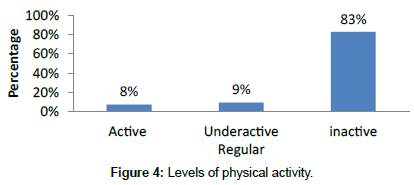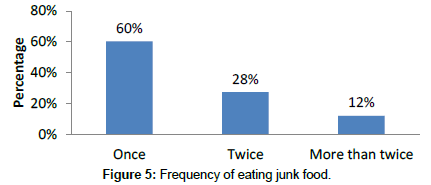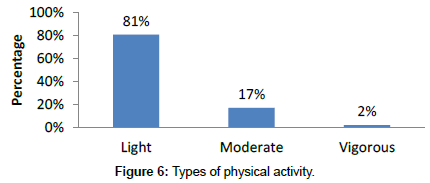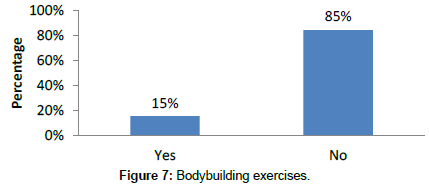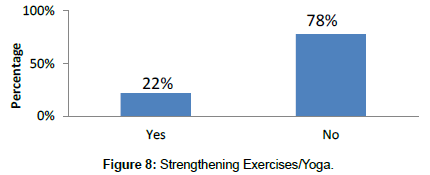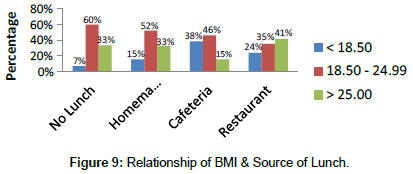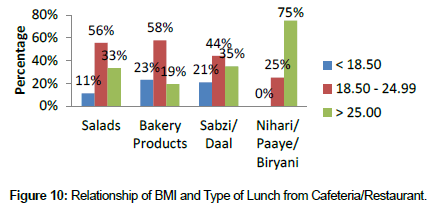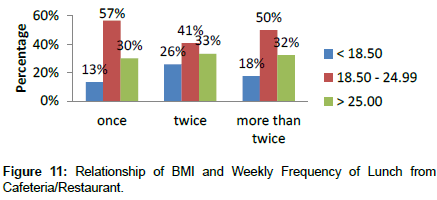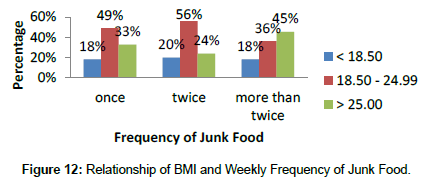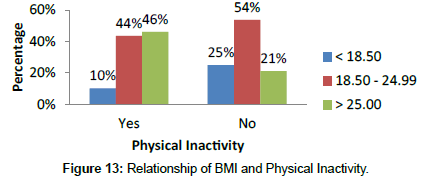Research Article, J Food Nutr Disor Vol: 7 Issue: 1
Assessment of Diet and Physical Activity Correlation with BMI
Muhammad Yasir Tarar*, Muhammad Talha Farooq and Rana Danish Iftikhar
Services Institute of Medical Sciences, Services hospital Lahore, Pakistan
*Corresponding Author : Muhammad Yasir Tarar, M.B.B.S
Services Institute of Medical Sciences, Services hospital Lahore, PMDC # 85890-P, Medical Officer (THQ Chunian), Pakistan
Tel: 03364243493
E-mail: yasirtarar1@gmail.com
Received: January 25, 2018 Accepted: February 15, 2018 Published: February 20, 2018
Citation: Tarar MY, Farooq MT, Iftikhar RD (2018) Assessment of Diet and Physical Activity Correlation with BMI. J Food Nutr Disor 7:1. doi: 10.4172/2324-9323.1000244
Abstract
Assessment of Diet and Physical Activity Correlation with BMI
Objectives: • To evaluate the impact of long working hours on diet and physical activity • To find out the relationship between diets, physical activity and BMI of officials having long work hours. Methodology: It’s a Cross sectional study carried out over the period of 2 months in different private sector offices. The targeted population was officials of 20-45 years of age having more than 48 hr of work a week for last 5 year. Sample size of 100 officials was selected. Officials were selected through randomized sampling Officials more than 45 yrs of age with documented diagnosis of chronic diseases were excluded to avoid disparity in results. Data was collected from Allied Bank of Pakistan (Lahore), Faysal Bank Ltd. (Lahore), Nawa-i-Waqt Newspaper Office (Lahore) with the help of structured questionnaire and anthropometric indices were calculated using standard tools for measuring height, weight and body mass index. Informed consent was taken prior to asking questions from respondent. Anonymity of the respondents was also guaranteed. Data was analyzed by using SPSS version 17 and Microsoft Excel 2010. Result: Following results were obtained: Our sample comprises of 100 subjects 80 out of which are male and 20 females.80%of the population have a post-graduation degree, 15% are graduates and 5% are undergraduates.51%of the population has homemade meal for lunch while 49% eat bakery item and visit restaurants out of which 37% of the population go to restaurants more the twice a week.83% of the officials have no physical activity. While 9% have light physical activity. 32% of the population has a BMI greater than normal limits(18.50-24.99).60% of population who don’t have lunch has a BMI within normal limits(18.50-24.99).subject having homemade lunch 52% of them has BMI in normal limits (18.50- 24.99) while people having lunch at cafeteria and restaurants 41% of them has BMI above the normal limit. Population having junk food more than twice a week 32% of them has BMI above normal limits. Conclusion: Majority of the officials don’t indulged in any kind of physical activity and if done it is not up to the standard criteria leading to increased BMI. The BMI & dietary habits on other hand depict healthy life styles adopted by most of them.
Keywords: Physical activity; BMI; Dietary habits
Introduction
Effects of diet and physical activity on health often interact, particularly in relation to obesity [1]. Obesity is increasing in the US population at a shocking rate. During the past ten years, the prevalence of obesity has increased by 33%. Currently, 69% of US adults are overweight or obese. Overweight and obesity are major public health concerns because of their high prevalence and their link with serious health morbidities [2] similar trends are seen in developing countries where increasing incidence of noncommunicable diseases is partly attributed to the changing trends in dietary intake combined with sedentary life style, stress exposure and less physical activity [3]. A study conducted on Iranian female administrative officials illustrated that high-calorie snacks and sedentary lifestyle are among the main reasons of getting more fat in them [4]. A study conducted on Norwegian officials showed that frequent eating in staff canteens particularly in officials was positively associated with unhealthy dietary habits, explaining higher odds for obesity among them [5]. National Health Survey of Pakistan (1990- 94) when reanalyzed to assess prevalence of obesity in the adult Pakistani population using BMI cut-offs recommended for Asians, depicted increasing occurrence of overweight people. In South Asia, including Pakistan, social and environmental changes are occurring rapidly, with increasing urbanization, changing lifestyles, higher energy density of diets, and reduced physical activity [6].
Methods
Objectives
• To evaluate the impact of long working hours on diet and physical activity.
• To find out the relationship between diets, physical activity and BMI of officials having long work hours.
Methodology
Methods includes
Study design: Cross sectional descriptive study.
Study settings: Officials (male and female) involved in desk jobs were enrolled in study.
Sample size: 100
Sampling technique: Randomized Sampling.
Inclusion criteria: Officials of 20-45 years of age having more than 48hrs of work a week for the last 5 years.
Exclusion criteria: Officials more than 45 years of age with documented diagnosis of diabetes, hypertension, coronary heart disease, metabolic disorders e.g. Cushing’s syndrome, hypothyroidism or having genetic predisposition for obesity were excluded to avoid disparity in results.
Data collection:
• Allied Bank of Pakistan (Lahore)
• Faysal Bank Ltd. (Lahore)
• Nawa-i-Waqt Newspaper Office (Lahore)
Data connection tool: The study was conducted with the help of structured questionnaire. Anthropometric indices were calculated using standard tools for measuring height, weight and body mass index.
Ethical consideration: Informed consent was taken prior to asking questions from respondents. Anonymity of the respondents was also guaranteed.
Data analysis: Data was analyzed by using SPSS version 17 and Microsoft Excel 2010.
Result
Following results were obtained (Figures 1-13).
• Our sample comprises of 100 subjects 80 out of which are male and 20 females.
• 80% of the populations have a post-graduation degree, 15% are graduates and 5% are undergraduates.
• 51% of the population has homemade meal for lunch while 49% eat bakery item and visit restaurants (Figure 1).
• 37% of the population go to restaurants more the twice a week (Figure 2).
• 32% of the population has a BMI greater than normal limits (18.50-24.99) (Figure 3).
• 83% of the officials have no physical activity. While 9% have light physical activity (Figure 4).
• 60% of population who don’t have lunch has a BMI within normal limits (18.50-24.99) (Figure 9).
• Subject having homemade lunch 52% of them has BMI in normal limits (18.50-24.99) (Figure 9).
• People having lunch at cafeteria and restaurants 41% of them have BMI above the normal limit (Figure 9).
• Population having junk food more than twice a week 32% of them has BMI above normal limits (Figure 12).
Discussion
Corpulence and obesity is emerging as a national health problem in Pakistan, where it mostly affects middle aged women and men, which are proved in our study where it was observed that considerable proportion (32%) of people with long sedentary working hours, have higher BMI suggesting a tendency towards being overweight. This is also in line with another study conducted on Australian workers according to which the decreased physical activity and long working hours cause an increase in the BMI [7].
Although physical inactivity is now identified as the fourth leading risk factor for global mortality [8], in our study majority of officials do not indulge in any physical activity and exercise. They remain deskbound for most of their work time. Similar results were found in a study THE CONTRIBUTION OF OFFICE WORK TO SEDENTARY BEHAVIOUR ASSOCIATED RISK which showed that office workers remain torpid for a very long fraction of their work hours and inactive periods during work hours accounted for nearly half of their total weekly sedentary time [9].
Besides cafeteria and restaurant lunch, a healthy activity i.e. preference of homemade food was found among office workers (50%). This is in contrast to a study which showed that workers with long working hours indulged in less healthful food habits and mostly used cold food vending machines [10].
It was seen in our study that only 8% officials are truly active which is an alarming sign observed in a study conducted in 2011: Physical activity and dietary fat intake influence BMI in a crosssectional correlational design. BMI increases greatly with decrease in minutes spent in physical activity [11].
Conclusion
Majority of the officials don’t indulged in any kind of physical activity and if done it is not up to the standard criteria leading to increased BMI. The BMI and dietary habits on other hand depict healthy life styles adopted by most of them.
References
- World Health Organization (2004) Global Strategy on Diet, Physical Activity and Health.
- French AS, Harnack JL, Toomay LT, Hannan JP (2007) Association b/w body weight,physical activities and food choices among metropolitan transit workers. Int J Behav Nutr Phys Act 4: 52.
- Sossa C, Delisle H, Agueh V, Sodjinou R, Ntandou G, et al. (2013) Lifestyle and Dietary factors associated with the evolution of Cardiometabolic risk over 4 years in West-African adults: The Benin study. J Obes.
- Amani R, Boustani F (2008) Prevalance of obesity and dietary practices in jondi-shapour university female personnal, Ahvaz, Iran. Pak J Med Sci 24: 748-752.
- Kjollesdal MR, Holmboe-Ottesen G, Wandel M (2011) Frequent use of staff canteens is associated with unhealthy dietary habits and obesity in a Norwegian adult population. Public Health Nutr 14: 133-141.
- Nanan JD (2002) The obesity pandemic-implications for Pakistan. JPMA 52: 342.
- Ostryl SA, Radi S, Louie MA, LaMontagne DA (2006) Psychosocial and other working conditions in relation to BMI in a representative sample of Australian workers. BMC Public Health 6: 53.
- World Health Organization (2011) Global recommendations on physical activity for health.
- Parry S, Straker L (2013) The contribution of office work to sedentary behaviour associated risk. BMC Public Health 13: 296.
- Escoto KH, French SA, Harnack LJ, Toomey TL, Hannan PJ, et al. (2010) Work hour, weight status and weight related behaviors: A study of metro transit workers. Int J Behav Nutr Phys Act 7: 91.
- Omondi OD, Othuon AOL, Mbagaya MG (2011) Can physical activity and dietary fat intake influence BMI in a crosssectional corelated design? World Acad Sci Eng Technol 5:9.
 Spanish
Spanish  Chinese
Chinese  Russian
Russian  German
German  French
French  Japanese
Japanese  Portuguese
Portuguese  Hindi
Hindi 